| 1. |
Did you write books as a kid?
|
Yes, with help from my mom. I drew the pictures and told her the
story and she wrote in the words.
|

|
|
When I could write words on my own, I wrote an autobiography.
|

|
| 2. |
What kid's books did you grow up with?
|
We had a very old edition of Edward Lear's BOOK OF NONSENSE, which
my sister and I colored in. WINNIE-THE-POOH was also a favorite. And Maurice Sendak's WHERE THE WILD THINGS ARE and his NUTSHELL LIBRARY, along with a bunch of books
by Dr. Seuss.
|

Edward Lear
|
| 3. |
Did you always want to be an author? |
No. In college I thought I'd be a painter or make movies. But I also created
a lot of comic strips, which are kind of a cross between paintings and movies.
And that led to picture books.
|
| 4. |
How did you first get published? |
A publisher saw my pictures and suggested I write a picture book story.
So I did. It was two sentences long.
|
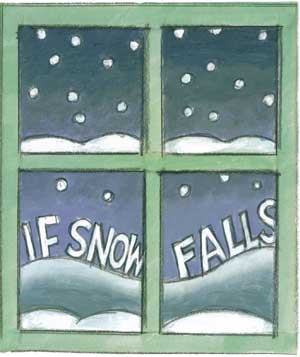
|
| 5. |
What do you like about writing a book? |
I like taking an implausible, off-the-wall idea, and seeing where it will go.
|
|
| 6. |
Where did you get the idea for MILO'S HAT TRICK?
|
|
|
Like most of my story ideas, from drawing. And from asking
questions. In this case the first question was "where do magicians
get their rabbits?" Instead of looking for the answer in a book or on
the internet, I came up with my own ridiculous explanation, which set
the story in motion.
|

|
| 7. |
Are any of your stories inspired from real life?
|
Yes, THE RETIRED KID. One day I saw a bunch of kids getting off a school bus
and they were all weighed down with back packs, suitcases, trumpet cases,
lunch boxes, art projects, etc., and I thought — wow — it's
hard work being a kid!
|
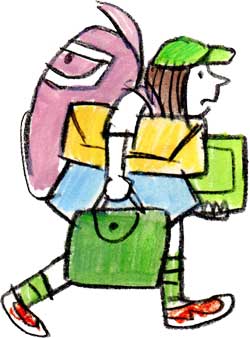
|
| 8. |
What was the challenge of Z GOES HOME? |
|
|
Well, for starters, it's an alphabet book. And if you do an alphabet book it has to be
different from all the other alphabet books. Also, there is the issue of what to do with
those difficult letters Q and X.
|

QUICKSAND
|
| 9. |
How long does it take to write a book? |
Some books take six months, some take a year. MY RHINOCEROS was an exception. The story was written almost word for word in one afternoon. Finishing the art took three months.
|

|
| 10. |
What's the biggest headache about doing pictures for a picture book? |
|
|
The gutter. Where your beautiful double page spread gets swallowed up in the middle!
|

|
| 11. |
Do you do a lot of sketches before choosing the final drawing? |
|
|
It depends. Some pictures are harder than others. There was one in TERRIFIC, of Eugene and Lenny, when their boat is plowed into by a fishing trawler. I must have done that picture over twenty times.
|
 First sketch First sketch
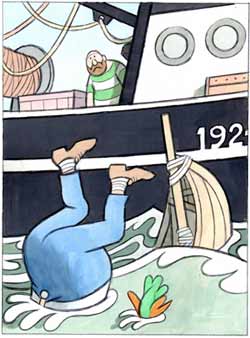 Final picture Final picture
|
| 12. |
What happens to the artwork after your book is published? |
Sometimes I sell it. Sometimes the pictures are exhibited in museums.
|
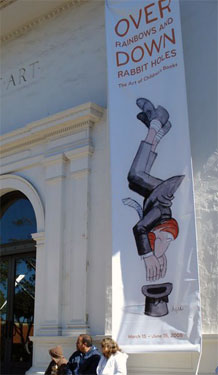
Santa Barbara Museum of Art
|
| 13. |
How did you come to illustrate William Steig's POTCH & POLLY?
|
|
|
I got to know Bill when he was in his eighties, when he and
his wife Jeanne were living in Boston. Bill had some stories lying
around, but he didn't have the energy to do the pictures for them.
|

|
| 14. |
Who has influenced your picture books? |
Tomi Ungerer comes to mind first. He did a number of extraordinary
picture books back in the 1970's, along with satirical posters and
collections of drawings. He was a brilliant graphic artist,
designer, and his books featured a host of delightfully wacky
characters.
|
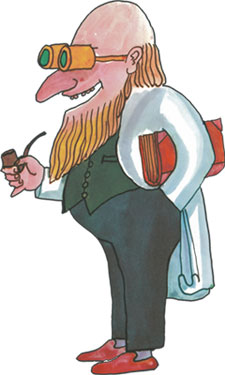
Dr. Van der Dunkel, from MOON MAN
Tomi Ungerer
|
|
I love Ludwig Bemelman's lively illustrations for MADELEINE and
his many other books. Also Andre Francois, Hans
Fischer, Saul Steinberg . . .
|
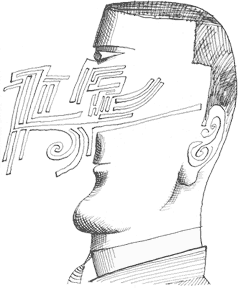
Saul Steinberg
|
|
. . . Janosch, Domenico Gnoli, Andre Helle, Lyonel Feininger, eastern
European posters, Hiroshige, Jules Feiffer, John Burningham, Max
Beckmann, Philip Guston...
|

Andre Helle
|
| 16. |
How do you write a palindrome? |
One way is to look at the words around you - in your house, in a shop, in a park, or on the side of the road. Maybe you're stuck in traffic, behind a SUBARU. You try spelling it backwards . . . URABUS. You add a D in the middle to get SUBARU DURABUS. Sure, it doesn't make much sense. So you draw a picture:
|

|
|
You might be in the kitchen and pull out a box of frozen LASAGNA.
Suddenly, you see that backwards, it spells ANGASAL, which for a
palindromist, is very promising. So you fiddle with the backward
spelling, separating it into possible words so you can build off it.
ANGASAL . . .
ANG A SAL . . .
ANG A SALAMI . . .
HANG A SALAMI!!
Wow! Now you check to see what the backward spelling spells going forward:
HANG A SALAMI the other way around is
I'M A LASAGNA H!! You're ecstatic! But you calm down,
pull yourself together and eventually
add the perfect letters to the front and back to complete the phrase:
GO HANG A SALAMI! I'M A LASAGNA HOG!
An excellent palindrome. But a picture always helps:
|
| 17. |
How do you write an anagram? |
An anagram is another word for rearranging letters. If you have a
Scrabble game on hand, take out the tiles and spell your name:
|
|
(OK, pretend you're Albert Einstein.)
Rearrange the tiles - using all of them - to come up with something new:
ELITE TENNIS BAR or
ELITE BRAIN NEST or . . .
TEN ELITE BRAINS! No wonder you're so smart!
|
| 18. |
Who has influenced your wordplay books?
|
|
|
B. Kliban, among others. He did an hilarious four-volume set of
oblong books, filled with his absurdist cartoons which are, by the way,
not all for kids.
|
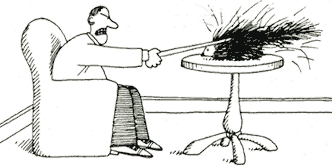
"WHACK YOUR PORCUPINE"
B. Kliban
|
| 19. |
What's your greatest moment in wordplay?
|
|
|
Being a clue in the New York Times Crossword Puzzle.
|
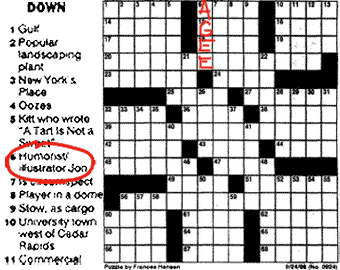
|
| 20. |
What advice would you give young hopeful authors and illustrators? |
The advice is boring, but it's simple; keep at it. Practice,
practice, practice. Read, draw, go to museums, go to great movies,
theater, dance. Absorb stuff and see what happens. And bring a pad
and pen.
|
|